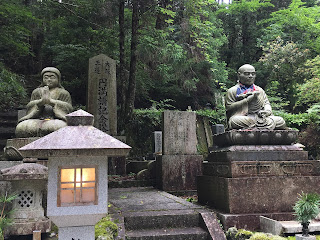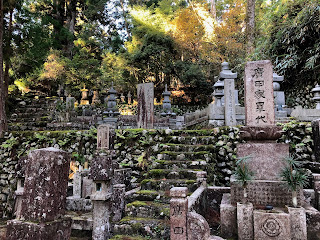-- Susan, every other Sunday
Obon (お盆) is an annual Buddhist observance to honor departed (deceased) ancestors, who are believed to return to the world of the living to visit us during the Obon holidays.
 |
| Monuments at Koyasan Okunoin |
This year, Japan will observe Obon from August 13-16. Many people will travel back to their birthplaces or ancestral villages for the observances.
In addition to family reunions, Obon observances customarily include the lighting of lanterns (to guide the spirits home), special dances called bon odori, visits to family graves and cemeteries, and special services and offerings at Buddhist temples.
 |
| Lanterns at Kasuga Taisha, Nara, Japan |
At the end of the festival, different lanterns are used to bid the spirits farewell and send them home. In many places, lanterns are set afloat in rivers or in the ocean for this purpose.
Obon celebrations in Kyoto and Hakone feature massive flaming kanji (Chinese characters used in written Japanese) on the nearby mountains.
 |
| In the summer, that massive "Dai" is lit ablaze (Hakone, Japan) |
In 2018, Annamaria Alfieri and I hiked up one of the mountains in Kyoto where these Obon fires are lit, and saw the metal cross pieces used to hold the massive logs in place.
 |
| The view from the Obon fire site |
 |
| One of the crosspieces |
 |
| Another (center) crosspiece used in Obon fires |
While Obon festivals were more subdued than usual last year, and will likely be smaller than usual this year too, Obon isn't the only time Japanese people remember friends and relatives who have passed away. Visits to cemeteries, and leaving incense and other offerings on graves, is common practice at any time of year.
 |
| Incense, before being left on graves |
Cemeteries aren't viewed as frightening or haunted places in Japan--and although many of them are haunted, they're also beautiful, peaceful places.
 |
| A cemetery in Narai, on the old Nakasendo Road through the Japan Alps |
 |
| Monuments at Koyasan Okunoin |
In many parts of Japan, the cemeteries are placed on hills overlooking nearby towns or villages.
 |
| The view from a cemetery in Magome, on the Nakasendo |
 |
| A cemetery overlooking the Ryuo-kyo (Gorge of the Dragon King), Tochigi, Japan |
An interesting side effect of this custom is that graves, and cemeteries, are not rare sights when traveling in Japan. Some, like Koyasan's Okunoin, are popular travel destinations in themselves.
 |
| Okunoin, Koyasan |
In either case, this is a country where it's easy to feel the presence of "those who have gone before"--regardless of your beliefs as to where their spirits may be now. Personally, I find it very comforting; it reminds me that I am a link in an infinite chain that stretches away from me in both directions, connecting me with the past, as well as the future.
In that sense, even those who have died remain alive and present--they may have physically gone to a place where we can no longer see them (and that hurts, from time to time) but as long as the rest of us endure, and remember them, in a very real way they still remain with us too--not only at Obon, at other times as well.
















How gorgeous, Susan! And that photo of the lanterns brought me right back! Ooh how I wish I could walk through that place with you again right this minute!
ReplyDeleteSusan, not only is your reporting a treasure to the the senses, but your personal philosophy--"Personally, I find it very comforting; it reminds me that I am a link in an infinite chain that stretches away from me in both directions, connecting me with the past, as well as the future"--a balm for the soul!
ReplyDeleteTraditionally, the dead are incinerated and their ashes deposited beneath or inside stone monuments, so this ritual is more about allowing the ancestors to keep an eye on those who remain—not just around Obon, but throughout the year.
ReplyDelete------------------------
Facebook Bellen